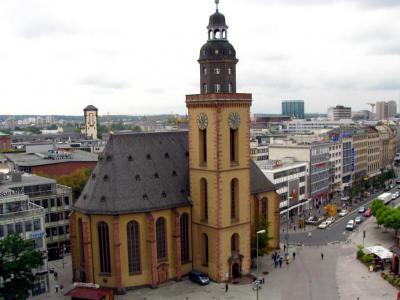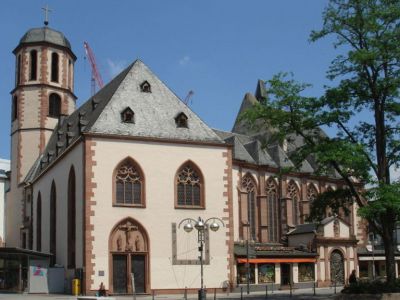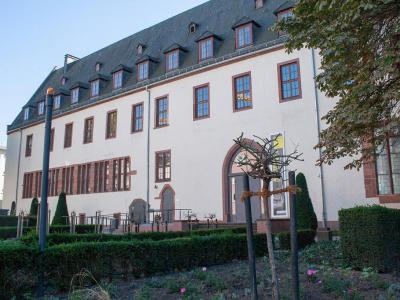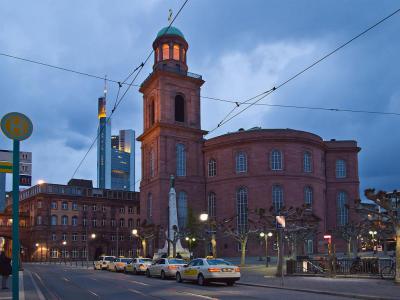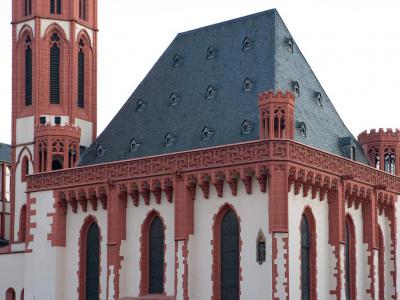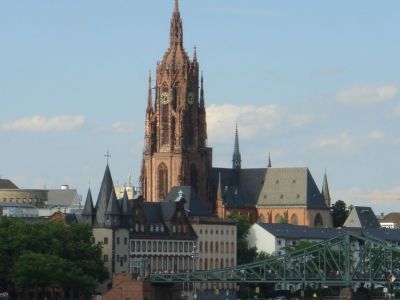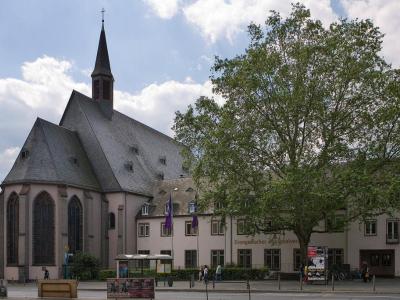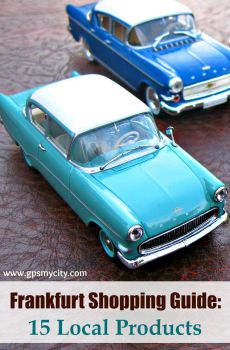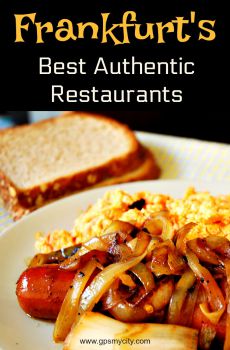Historical Churches Walking Tour (Self Guided), Frankfurt
Today Frankfurt is a predominantly secular city, but it still has a significant Christian presence.
The history of Christianity in Frankfurt dates back to the Middle Ages when, as a free city-state, it became an essential segment of the Holy Roman Empire. As the city grew, so did its Christian community. Several important churches appeared during that period, including the Old Nicholas Church (Alte Nikolaikirche), first built as a chapel in the 12th century, being one of the oldest churches in Frankfurt, and the 14th-century Church of Our Lady (Liebfrauenkirche). It is in reference to this house of worship that the expression "To see the light of the Liebfrauenkirche" was used to describe a moment of clarity or enlightenment.
For many years, Frankfurt was regarded as the city of the crowned kings, being the site of imperial coronations held at the Frankfurt Cathedral, aka the Cathedral of St. Bartholomew (Kaiserdom St. Bartholomäus).
In the 16th and 17th centuries, the city was at the heart of the Reformation movement in Germany, and in the 19th century, saw an increase in Catholic congregation. A prominent religious site from that period, St. Paul's Church (Paulskirche), is also notable for its role in German political history. In 1848, it housed the first democratically elected German National Assembly, nicknamed “St. Paul's Parliament” (Paulskirchenparlament). In this regard, Frankfurt was dubbed "the city of the Paulskirche," effectively marking the church as a national historic monument and a symbol of German democracy.
Religious or not, everyone is likely to be impressed by the architectural splendor or historical significance of Frankfurt's churches. We invite you to take this self-guided walking tour and explore some of the city's most formidable temples.
The history of Christianity in Frankfurt dates back to the Middle Ages when, as a free city-state, it became an essential segment of the Holy Roman Empire. As the city grew, so did its Christian community. Several important churches appeared during that period, including the Old Nicholas Church (Alte Nikolaikirche), first built as a chapel in the 12th century, being one of the oldest churches in Frankfurt, and the 14th-century Church of Our Lady (Liebfrauenkirche). It is in reference to this house of worship that the expression "To see the light of the Liebfrauenkirche" was used to describe a moment of clarity or enlightenment.
For many years, Frankfurt was regarded as the city of the crowned kings, being the site of imperial coronations held at the Frankfurt Cathedral, aka the Cathedral of St. Bartholomew (Kaiserdom St. Bartholomäus).
In the 16th and 17th centuries, the city was at the heart of the Reformation movement in Germany, and in the 19th century, saw an increase in Catholic congregation. A prominent religious site from that period, St. Paul's Church (Paulskirche), is also notable for its role in German political history. In 1848, it housed the first democratically elected German National Assembly, nicknamed “St. Paul's Parliament” (Paulskirchenparlament). In this regard, Frankfurt was dubbed "the city of the Paulskirche," effectively marking the church as a national historic monument and a symbol of German democracy.
Religious or not, everyone is likely to be impressed by the architectural splendor or historical significance of Frankfurt's churches. We invite you to take this self-guided walking tour and explore some of the city's most formidable temples.
How it works: Download the app "GPSmyCity: Walks in 1K+ Cities" from Apple App Store or Google Play Store to your mobile phone or tablet. The app turns your mobile device into a personal tour guide and its built-in GPS navigation functions guide you from one tour stop to next. The app works offline, so no data plan is needed when traveling abroad.
Historical Churches Walking Tour Map
Guide Name: Historical Churches Walking Tour
Guide Location: Germany » Frankfurt (See other walking tours in Frankfurt)
Guide Type: Self-guided Walking Tour (Sightseeing)
# of Attractions: 7
Tour Duration: 1 Hour(s)
Travel Distance: 2.0 Km or 1.2 Miles
Author: helenp
Sight(s) Featured in This Guide:
Guide Location: Germany » Frankfurt (See other walking tours in Frankfurt)
Guide Type: Self-guided Walking Tour (Sightseeing)
# of Attractions: 7
Tour Duration: 1 Hour(s)
Travel Distance: 2.0 Km or 1.2 Miles
Author: helenp
Sight(s) Featured in This Guide:
- Saint Catherine's (Katharinenkirche)
- Church of Our Dear Lady (Liebfrauenkirche)
- Carmelite Monastery (Karmeliterkloster)
- Paulskirche (St. Paul's Church)
- Old Nicholas Church (Alte Nikolaikirche)
- Frankfurt Cathedral (Cathedral of St. Bartholomew)
- Dominican Monastery (Dominikanerkloster)
1) Saint Catherine's (Katharinenkirche)
The Saint Catherine Church (Katherinenkirche), located near the busy Hauptwache Plaza in Frankfurt, is the largest Lutheran church in the city and was constructed between 1678 and 1681.
It stands on the site of a vestal cloister and hospital once run by the Teutonic Knights order. Later, a small parish church was built on the site which gained importance in history because, in 1522, it became the setting of the first protestant sermon in Frankfurt. The church was consecrated in 1681 and dedicated to the martyred Saint Catherine of Alexandria.
The single-vessel hall church had a tower at the side and ornamental gateways; just like many other buildings in the city, it was destroyed during the bombings of 1944. The parishioners and citizens of Frankfurt rebuilt the property in 1954, carefully reconstructing the original exterior, although with a somewhat simpler interior.
Among the well-known parishioners who have worshiped at Ketherinenkirche, over the years, were the likes of the Goethe family; Johann Wolfgang von Goethe was baptized here. Also, near the church, at some point, was the Katharinenpforte prison where, in 1771, a child murderer Susanna Margaretha Brandt was incarcerated. Her beheading strongly affected 22-year-old Goethe, who witnessed it. Later, he used some of the Brandt case details in the ‘Faust’ poem.
It stands on the site of a vestal cloister and hospital once run by the Teutonic Knights order. Later, a small parish church was built on the site which gained importance in history because, in 1522, it became the setting of the first protestant sermon in Frankfurt. The church was consecrated in 1681 and dedicated to the martyred Saint Catherine of Alexandria.
The single-vessel hall church had a tower at the side and ornamental gateways; just like many other buildings in the city, it was destroyed during the bombings of 1944. The parishioners and citizens of Frankfurt rebuilt the property in 1954, carefully reconstructing the original exterior, although with a somewhat simpler interior.
Among the well-known parishioners who have worshiped at Ketherinenkirche, over the years, were the likes of the Goethe family; Johann Wolfgang von Goethe was baptized here. Also, near the church, at some point, was the Katharinenpforte prison where, in 1771, a child murderer Susanna Margaretha Brandt was incarcerated. Her beheading strongly affected 22-year-old Goethe, who witnessed it. Later, he used some of the Brandt case details in the ‘Faust’ poem.
2) Church of Our Dear Lady (Liebfrauenkirche)
Set between the Zeil shopping street and the busy Romerberg square in Frankfurt is the Gothic-style church that dates back to the early Middle Ages. This is a functioning Catholic parish church and is part of the Capuchin monastery. The latter is open to the public and the Capuchin fathers regularly provide food for the needy and homeless near the main building.
The Liebfraukirche was donated by a Frankfurt aristocrat, Wigel von Wanebach, whose epitaph, dated 1322, is found in the church. After his death, Wigel's son and widow, Frog and Catherine of Wanebach, expanded the temple by adding a chapel.
The small church was further enlarged, in 1344, with a three-aisle Gothic hall. In 1415, the church's façade was adorned with what is considered to be its main treasure, a Tympanum, depicting the Adoration of the Magi by local architect Madern Gertheners.
In 1923, the Capuchin religious order took over the building. It was completely destroyed in World War II and remained in ruins until its reconstruction in 1956.
Visitors to the cathedral can spend a few moments of peace and contemplation in the simple yet spiritual ambiance of Liebfrauenkirche amid the busiest neighborhood of Frankfurt.
The Liebfraukirche was donated by a Frankfurt aristocrat, Wigel von Wanebach, whose epitaph, dated 1322, is found in the church. After his death, Wigel's son and widow, Frog and Catherine of Wanebach, expanded the temple by adding a chapel.
The small church was further enlarged, in 1344, with a three-aisle Gothic hall. In 1415, the church's façade was adorned with what is considered to be its main treasure, a Tympanum, depicting the Adoration of the Magi by local architect Madern Gertheners.
In 1923, the Capuchin religious order took over the building. It was completely destroyed in World War II and remained in ruins until its reconstruction in 1956.
Visitors to the cathedral can spend a few moments of peace and contemplation in the simple yet spiritual ambiance of Liebfrauenkirche amid the busiest neighborhood of Frankfurt.
3) Carmelite Monastery (Karmeliterkloster)
Formerly the convent of the Carmelite order, from 1246 to 1803, the Karmeliterkloster today houses the Institute for the History of Frankfurt and the Archaeological Museum.
After the Carmelites established themselves in Frankfurt in the mid-13th century, the monastery quickly gained footing and soon proved to be one of the largest building complexes in the Old Town. In 1424, its original single-vessel church was remodeled to the late Gothic style, with a chapel and two-aisle refectory hall added. The latter was richly adorned with frescoes, the largest in Northern Europe, including the painted history of the Carmelite order and the depiction of Christ’s birth and death by Jorg Ratgeb (the 16th-century artist who was later cruelly executed for partaking in the German peasant revolution of 1525).
Following the secularization of Frankfurt in 1803, the city claimed all the monastery's possessions, including 25 hectares of vineyards in Hochheim am Main. Over the years, the convent's main building served as a warehouse, garrison, fire department, and theater. It was almost destroyed during World War II and its frescoes were severely damaged. The building was finally refurbished in 1987-1989.
Since 1959, the Carmelite Monastery has housed the Institute for the History of Frankfurt (formerly the municipal archives) and the Archaeological Museum (once known as the Museum of Prehistory and Early History). Also on the premises, in the basement, is a cabaret theater called Die Schmiere (The Grease), staging satirical plays and much loved by the local theater-goers.
After the Carmelites established themselves in Frankfurt in the mid-13th century, the monastery quickly gained footing and soon proved to be one of the largest building complexes in the Old Town. In 1424, its original single-vessel church was remodeled to the late Gothic style, with a chapel and two-aisle refectory hall added. The latter was richly adorned with frescoes, the largest in Northern Europe, including the painted history of the Carmelite order and the depiction of Christ’s birth and death by Jorg Ratgeb (the 16th-century artist who was later cruelly executed for partaking in the German peasant revolution of 1525).
Following the secularization of Frankfurt in 1803, the city claimed all the monastery's possessions, including 25 hectares of vineyards in Hochheim am Main. Over the years, the convent's main building served as a warehouse, garrison, fire department, and theater. It was almost destroyed during World War II and its frescoes were severely damaged. The building was finally refurbished in 1987-1989.
Since 1959, the Carmelite Monastery has housed the Institute for the History of Frankfurt (formerly the municipal archives) and the Archaeological Museum (once known as the Museum of Prehistory and Early History). Also on the premises, in the basement, is a cabaret theater called Die Schmiere (The Grease), staging satirical plays and much loved by the local theater-goers.
4) Paulskirche (St. Paul's Church)
The oval-shaped church of Saint Paul in the Zeil district of Frankfurt is easily spotted for its red sandstone exterior. Formerly a protestant temple, it was built between 1789 and 1833 to serve the local Evangelical Lutheran congregation. Still, more than for its religious service and architecture, this neoclassical-style edifice is renowned for its role in the shaping of German democracy.
In 1848, during the so-called German revolutions, the Frankfurt Parliament convened here, being the first publicly and freely-elected German legislative body. The parliamentarians chose the building because of its typical Protestant centralized design, allowing everybody to easily hear the speaker.
In 1848, the National Assembly met inside the church for the first time and was therefore named the Paulskirchenparlament. Representatives from Germany and Austria worked on the premises until 1849 to draft a Charter of Basic Rights and a Constitution for a united Germany on the basis of popular self-determination. The attempt subsequently failed and the building resumed service as a church.
During WWII, Paulskirsche suffered extensive damage from bombings. After the war, its exterior was painstakingly restored, while the interior was somewhat simplified. Nonetheless, the striking feature of the interior is a modern mural depicting the procession of the people’s representatives into Paulskrische which today stands as the symbol of German democracy.
Presently, the building is used as a venue for various events and exhibitions including the Peace Prize of the German Book Trade and the Goethe Prize by the city of Frankfurt. The hall on the first floor is used for municipal and other functions.
Why You Should Visit:
Free entry, with a wealth of information in English covering the German democratic process.
Tip:
Pop in for the excellent art exhibition in the basement (pieces are for sale but are on the expensive side).
Upstairs you can visit the room in which JFK gave his brief speech in 1963.
In 1848, during the so-called German revolutions, the Frankfurt Parliament convened here, being the first publicly and freely-elected German legislative body. The parliamentarians chose the building because of its typical Protestant centralized design, allowing everybody to easily hear the speaker.
In 1848, the National Assembly met inside the church for the first time and was therefore named the Paulskirchenparlament. Representatives from Germany and Austria worked on the premises until 1849 to draft a Charter of Basic Rights and a Constitution for a united Germany on the basis of popular self-determination. The attempt subsequently failed and the building resumed service as a church.
During WWII, Paulskirsche suffered extensive damage from bombings. After the war, its exterior was painstakingly restored, while the interior was somewhat simplified. Nonetheless, the striking feature of the interior is a modern mural depicting the procession of the people’s representatives into Paulskrische which today stands as the symbol of German democracy.
Presently, the building is used as a venue for various events and exhibitions including the Peace Prize of the German Book Trade and the Goethe Prize by the city of Frankfurt. The hall on the first floor is used for municipal and other functions.
Why You Should Visit:
Free entry, with a wealth of information in English covering the German democratic process.
Tip:
Pop in for the excellent art exhibition in the basement (pieces are for sale but are on the expensive side).
Upstairs you can visit the room in which JFK gave his brief speech in 1963.
5) Old Nicholas Church (Alte Nikolaikirche)
The Old Nicholas Church (German: Alte Nikolaikirche), located near the Römer city hall in the Old Town (Altstadt) of Frankfurt, is a medieval Lutheran temple dedicated to Saint Nicholas, the patron saint of fishermen. The current building dates back to the mid-15th century, replacing the original chapel on this site that stood since the mid-12th century. The foundations of the previous Nikolaikirche found during excavations are now marked on the floor and give the impression of its dimensions.
The Reformation proved a turning point in the history of Nikolaikirche. In the 15th century, the existing structure had a tower with leveled roof and a balcony added. The latter served as a viewing gallery for aristocrats when passion plays and other events took place in the plaza below. In 1543, the church was closed and its altars were demolished.
Over the next 150 years, the building was leased and used as an archive for the municipal jury and, at times, as a warehouse during trade fairs. A trumpeter watchman, stationed in the steeple, announced the arrival of boats up and down the River Main by blowing a horn. The bugle also sounded, like the modern-day alarm, whenever fires were sighted.
In 1838, the church was completely renovated. The previously closed northern portal facing Saturday Mountain was opened, and the roof, gallery, and corner turret were renewed. In 1903, the damaged cast-iron spire was torn down and replaced a year later by the pointed copper roof that still exists.
During World War II, the Alte Nikolaikirche was one of the very few historical buildings in downtown Frankfurt to be spared from destruction by aerial warfare. Only the 19th-century organ, despite being walled in, had become unusable from the effects of the war for reasons not quite known. The reconstruction of the building, which started in the summer of 1947, was completed relatively quickly, by the end of December 1948.
The church has a double aisle hall with a high Gothic choir and 51 bells, four of which are used for peals and 47 for carillons. The church is also renowned for its acoustics. Organ concerts, hand bells, trumpets, choirs, and brass bands perform here regularly. Another attraction is the spiral stairway leading to the gallery which affords a spectacular view of Romerberg Plaza.
The Reformation proved a turning point in the history of Nikolaikirche. In the 15th century, the existing structure had a tower with leveled roof and a balcony added. The latter served as a viewing gallery for aristocrats when passion plays and other events took place in the plaza below. In 1543, the church was closed and its altars were demolished.
Over the next 150 years, the building was leased and used as an archive for the municipal jury and, at times, as a warehouse during trade fairs. A trumpeter watchman, stationed in the steeple, announced the arrival of boats up and down the River Main by blowing a horn. The bugle also sounded, like the modern-day alarm, whenever fires were sighted.
In 1838, the church was completely renovated. The previously closed northern portal facing Saturday Mountain was opened, and the roof, gallery, and corner turret were renewed. In 1903, the damaged cast-iron spire was torn down and replaced a year later by the pointed copper roof that still exists.
During World War II, the Alte Nikolaikirche was one of the very few historical buildings in downtown Frankfurt to be spared from destruction by aerial warfare. Only the 19th-century organ, despite being walled in, had become unusable from the effects of the war for reasons not quite known. The reconstruction of the building, which started in the summer of 1947, was completed relatively quickly, by the end of December 1948.
The church has a double aisle hall with a high Gothic choir and 51 bells, four of which are used for peals and 47 for carillons. The church is also renowned for its acoustics. Organ concerts, hand bells, trumpets, choirs, and brass bands perform here regularly. Another attraction is the spiral stairway leading to the gallery which affords a spectacular view of Romerberg Plaza.
6) Frankfurt Cathedral (Cathedral of St. Bartholomew) (must see)
Frankfurt Cathedral is a Gothic-style Roman Catholic temple dedicated to Saint Bartholomew. This is the main and by far the largest religious site in Frankfurt – the height of its spire reaches 95 meters. Despite the name – Kaiserdom (Imperial Cathedral), or simply the Dom, – it has never been a cathedral in the true sense of the word but is only called so for its importance as a former coronation church of the Holy Roman Empire.
The present building on the site is the third one. The very first church (Merovingian chapel) was built here in the 7th century, which was then replaced, by a grander temple, in 1250. In 1356, Charles IV, Holy Roman Emperor issued the Golden Bull whereby all emperors of the Holy Roman Empire were to be elected in this collegiate church as kings of Germany; from 1562 to 1792, all emperors-elect were crowned here.
In 1867, Saint Bartholomew's was destroyed by fire and rebuilt in its present style. During WWII, between October 1943 and March 1944, the Old Town of Frankfurt was devastated by the Allied Forces' air bombardments. The cathedral also suffered severe damage; its interior burned out completely and was reconstructed only in the 1950s.
Saint Bartholomew's houses many splendid works of art, including a unique high altar and the Maria Schlaf altar found in Saint Mary’s chapel. Also, there is an Anthony Van Dyke painting, ‘The Lamentation’, and a museum with many historic pieces including objects discovered in a grave of a Merovingian girl.
Why You Should Visit:
Admission is free and, if lucky, you may enjoy some impressive organ music, too, or take in panoramic views of Frankfurt from atop the cathedral's tower (for a small fee).
Tip:
Try and go on a weekday to avoid the weekend crowd; make sure to bring a bottle of water if you decide to climb the tower.
The present building on the site is the third one. The very first church (Merovingian chapel) was built here in the 7th century, which was then replaced, by a grander temple, in 1250. In 1356, Charles IV, Holy Roman Emperor issued the Golden Bull whereby all emperors of the Holy Roman Empire were to be elected in this collegiate church as kings of Germany; from 1562 to 1792, all emperors-elect were crowned here.
In 1867, Saint Bartholomew's was destroyed by fire and rebuilt in its present style. During WWII, between October 1943 and March 1944, the Old Town of Frankfurt was devastated by the Allied Forces' air bombardments. The cathedral also suffered severe damage; its interior burned out completely and was reconstructed only in the 1950s.
Saint Bartholomew's houses many splendid works of art, including a unique high altar and the Maria Schlaf altar found in Saint Mary’s chapel. Also, there is an Anthony Van Dyke painting, ‘The Lamentation’, and a museum with many historic pieces including objects discovered in a grave of a Merovingian girl.
Why You Should Visit:
Admission is free and, if lucky, you may enjoy some impressive organ music, too, or take in panoramic views of Frankfurt from atop the cathedral's tower (for a small fee).
Tip:
Try and go on a weekday to avoid the weekend crowd; make sure to bring a bottle of water if you decide to climb the tower.
7) Dominican Monastery (Dominikanerkloster)
The Dominican Monastery in Frankfurt is the earliest church and Christian monastery in the city. Today, it serves as an exhibition hall and meeting place and is the seat of the Protestant Evangelical Association consisting of Evangelical Churches and Deaneries in the region. The Synod of the Evangelical Church in Hessen and Nassau is convened here, twice a year.
Established in 1233, the monastery was off to a humble beginning. The first Dominican brothers built a small house with four rooms and set about their task of providing religious instruction to the local people. The small house served as an entrance to the monastery.
By the 14th century, the sanctuary had evolved and accommodated numerous scholars, receiving generous donations from citizens in appreciation of the good work performed by the monks. With this, richly decorated monastery buildings, including a chapel, were constructed, featuring Gothic style and made of rubble stone. After the Reformation, the property was taken over by the Lutherans and then, during the secularization period, was apprehended by the municipal authorities and put to various non-religious uses.
The monastery was almost destroyed during WWII. After the war, architect Gustav Scheinpflug designed a new complex – also in Gothic style, but with modern interiors – based on the layout of the old monastery. Only the choir of the Holy Ghost Church remains from the old building.
Each summer, the monastery courtyard plays host to a folk theater show and concerts by the Frankfurt Church Music Association.
Established in 1233, the monastery was off to a humble beginning. The first Dominican brothers built a small house with four rooms and set about their task of providing religious instruction to the local people. The small house served as an entrance to the monastery.
By the 14th century, the sanctuary had evolved and accommodated numerous scholars, receiving generous donations from citizens in appreciation of the good work performed by the monks. With this, richly decorated monastery buildings, including a chapel, were constructed, featuring Gothic style and made of rubble stone. After the Reformation, the property was taken over by the Lutherans and then, during the secularization period, was apprehended by the municipal authorities and put to various non-religious uses.
The monastery was almost destroyed during WWII. After the war, architect Gustav Scheinpflug designed a new complex – also in Gothic style, but with modern interiors – based on the layout of the old monastery. Only the choir of the Holy Ghost Church remains from the old building.
Each summer, the monastery courtyard plays host to a folk theater show and concerts by the Frankfurt Church Music Association.
Walking Tours in Frankfurt, Germany
Create Your Own Walk in Frankfurt
Creating your own self-guided walk in Frankfurt is easy and fun. Choose the city attractions that you want to see and a walk route map will be created just for you. You can even set your hotel as the start point of the walk.
Shopping Streets
Frankfurt may well be an international business center in the first place, but not everything, by far, revolves here around finance. The city can also provide a top shopping experience for those seeking to invest in international and best German designer merchandise.
"Frankfurt is a shopping paradise - if you're a bird!" they say. This is a humorous way of saying that Frankfurt... view more
Tour Duration: 1 Hour(s)
Travel Distance: 2.1 Km or 1.3 Miles
"Frankfurt is a shopping paradise - if you're a bird!" they say. This is a humorous way of saying that Frankfurt... view more
Tour Duration: 1 Hour(s)
Travel Distance: 2.1 Km or 1.3 Miles
Old Town Walking Tour
The German city of Frankfurt, also known as Frankfurt am Main, has a long and complex history, spanning more than a thousand years. The Romans established a military camp called "Nida" in the area that is now Frankfurt, on the northern bank of the River Main, in the 1st century AD.
The town itself was founded by the Franks, a Germanic tribe, in the 9th century. Its name comes from... view more
Tour Duration: 2 Hour(s)
Travel Distance: 3.2 Km or 2 Miles
The town itself was founded by the Franks, a Germanic tribe, in the 9th century. Its name comes from... view more
Tour Duration: 2 Hour(s)
Travel Distance: 3.2 Km or 2 Miles
Jewish History Walking Tour
The history of Jews in Frankfurt dates back almost 900 years, which is more than in any other German city. Attesting to this fact alone is one of the oldest Jewish cemeteries in Europe, the Old Jewish Cemetery of Frankfurt, first recorded in the 12th century.
At some point, the city was even referred to as "Jerusalem of the West", highlighting its importance as a center of Jewish life... view more
Tour Duration: 1 Hour(s)
Travel Distance: 2.4 Km or 1.5 Miles
At some point, the city was even referred to as "Jerusalem of the West", highlighting its importance as a center of Jewish life... view more
Tour Duration: 1 Hour(s)
Travel Distance: 2.4 Km or 1.5 Miles
Useful Travel Guides for Planning Your Trip
15 Distinctively German Things to Buy in Frankfurt
Home to the European currency (ECB) and namesake sausages, Frankfurt is undoubtedly one of, if not "the", most known destination in Germany. For this there are quite a few reasons. Listed here are some of the things behind those reasons, which now can be picked up as...
Frankfurt's Best Authentic Restaurants
Frankfurt is a dynamic and popular city located right in the center of western Europe. More than 10,000 people move to Frankfurt every year; over the past decades, it has become a highly international city -- about half of all children born here had non-German parents. Being the main hub for the...
The Most Popular Cities
/ view all



